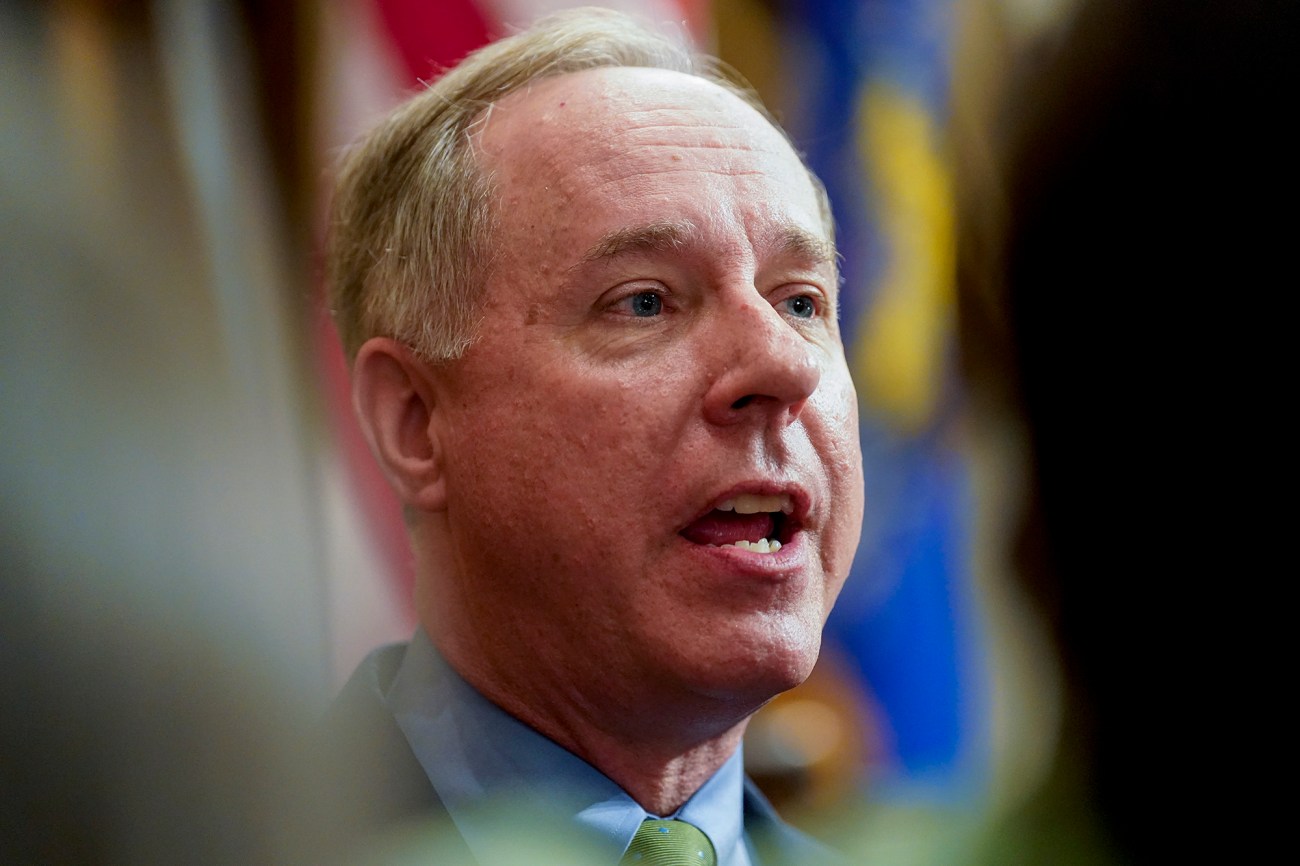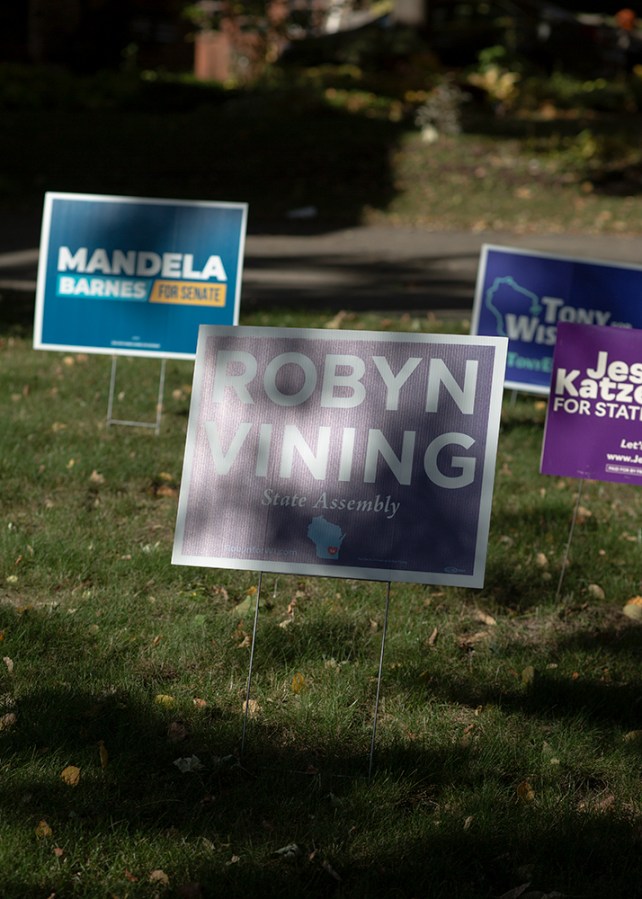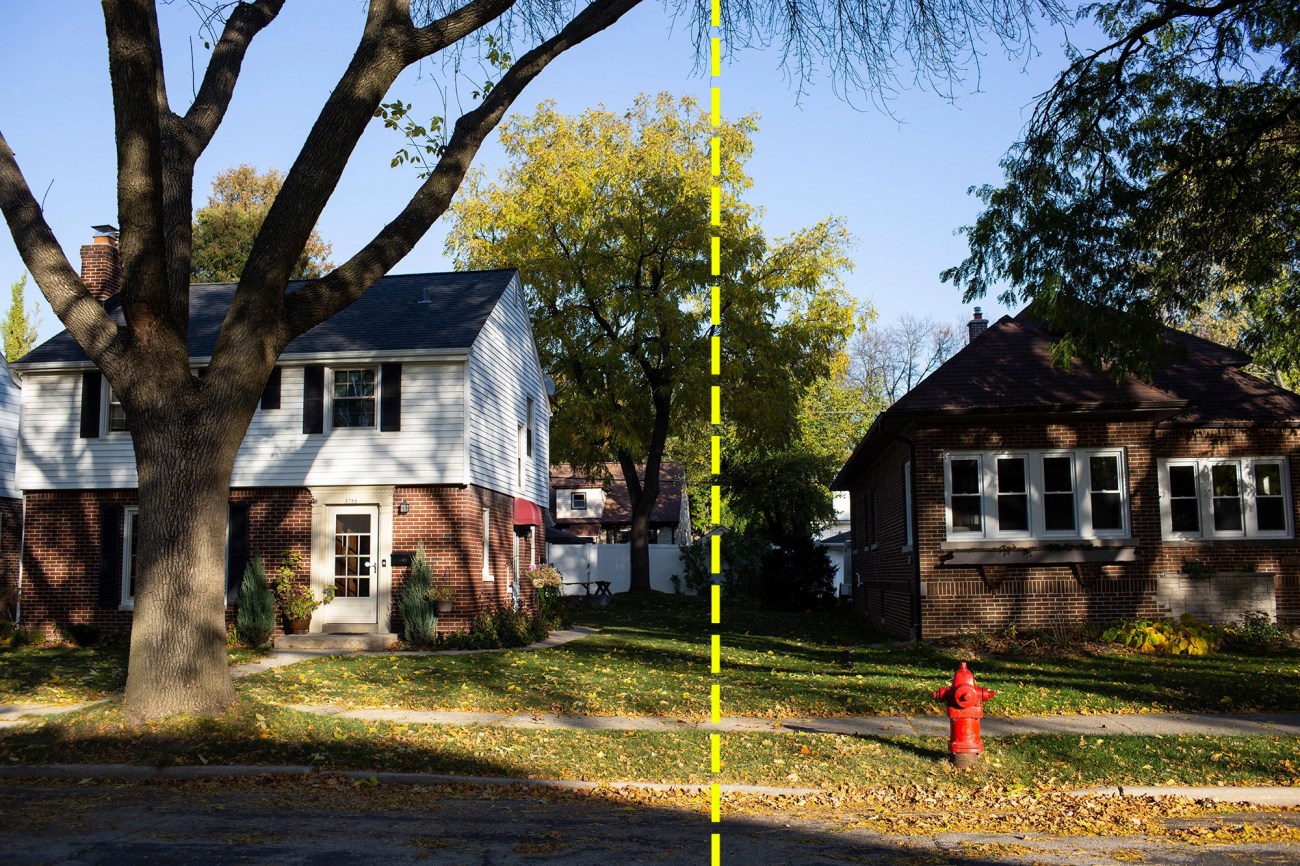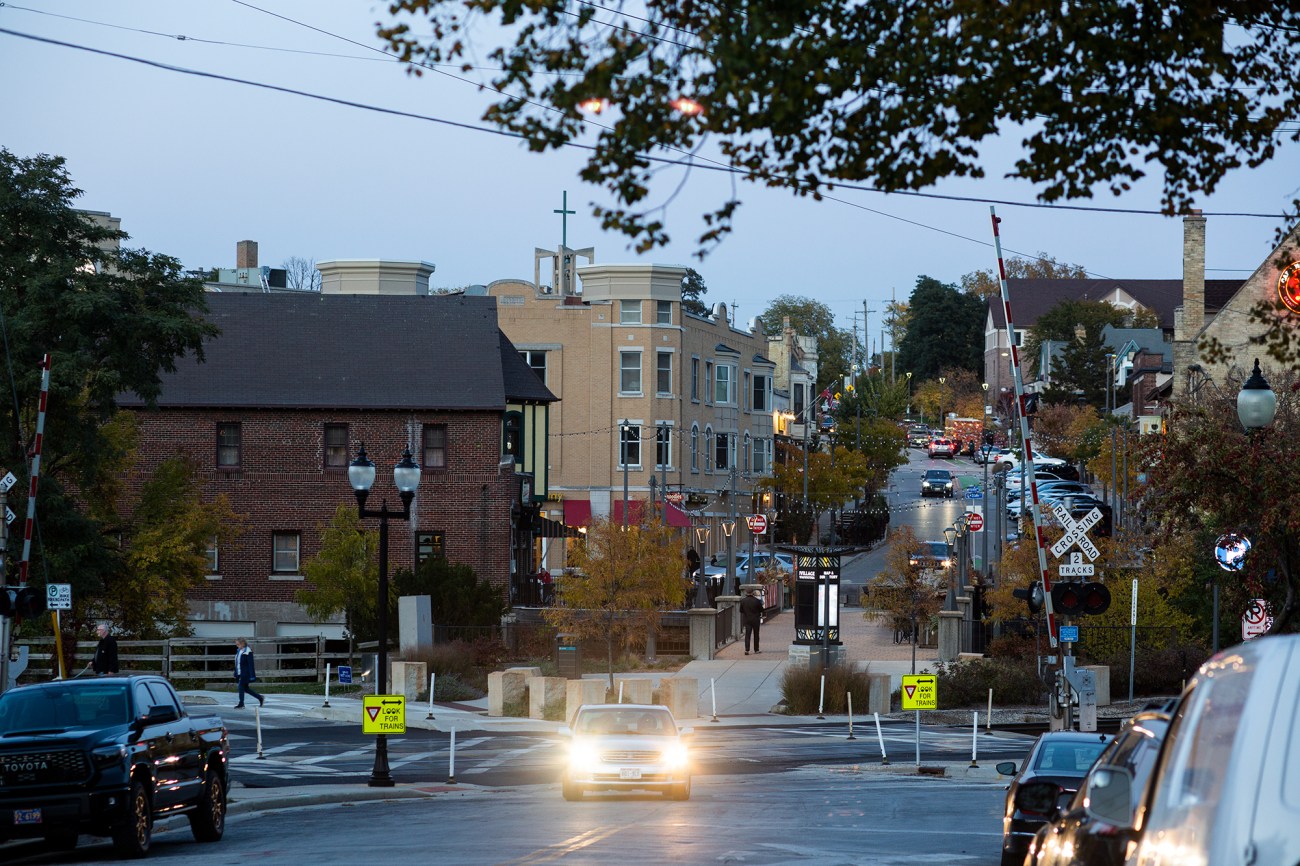It was six weeks before the November election, and in his snug campaign office in suburban Milwaukee, located in a shopping plaza between a dentist and an acupuncturist, Wisconsin Gov. Tony Evers scanned the brightly colored maps that hung on the walls. They depicted the tortuously shaped legislative districts drawn in a state regarded as one of the most gerrymandered in the nation. “Who in their right minds could’ve made them up?” Evers asked.
For more articles read aloud: download the Audm iPhone app.
The answer: Republicans in the state legislature. Evers saw firsthand the impact of GOP control of the redistricting process when he ran for governor in 2018. That year, Democrats swept all four statewide races and won 53 percent of votes cast for the state Assembly, but the party retained just 36 percent of seats in the chamber. “There’s something wrong with that picture,” Evers said, after polishing off a Five Guys burger for lunch.
Evers, 71, is a mild-mannered, grandfatherly figure who could not be more old-school Wisconsin. He likes polka, the card game euchre, and Egg McMuffins—despite being “so irritated at McDonald’s” for no longer offering breakfast after 10:30 a.m. “He’s got more of a Clark Kent vibe than a Superman vibe,” Barack Obama joked when he campaigned for Evers in Milwaukee a week before the election.
After serving as the state’s school superintendent for nearly a decade, Evers ran against then-Gov. Scott Walker on meat-and-potato issues; his signature phrase on the campaign trail was “fix the damn roads.” But in his reelection campaign in 2022, he faced a more existential battle: to preserve what’s left of democracy in the state.
If the redistricting maps drawn in secret by Republican staffers and passed by the GOP-controlled legislature in 2011 were unfair, the maps adopted by Republicans in 2021, over Evers’ objections, were even more one-sided. As a result, the number of GOP-leaning seats increased to 63 out of 99 in the state Assembly and to 23 out of 33 in the state Senate. That meant that—according to calculations by Marquette University Law School research fellow John Johnson—Democrats would have to win the 2022 statewide vote by 12 points just to get to 50 seats in the Assembly, while Republicans could garner a majority with only 44 percent of the vote.

Governor Tony Evers in Wauwatosa.
Lianne Milton
At the state GOP convention back in May, held at a Marriott in suburban Madison, GOP Assembly leader Robin Vos candidly laid out his plan for total domination of state politics. His top priority, he said, was defeating Evers. But short of that, if Republicans picked up one more seat in the Senate and five in the Assembly, Vos explained, that would give them a two-thirds supermajority that would “make Tony Evers irrelevant.”
That supermajority would have given legislative Republicans unfettered authority to override Evers’ vetoes and the power to implement an extreme and unpopular agenda on issues ranging from guns to education to abortion—including, potentially, the ability to overturn election results. “If Republicans get supermajorities in the state legislature,” Wisconsin Democratic Party chair Ben Wikler warned before the election, “it’s a threat to the foundations of American democracy.”
On November 8, Vos’ first plan failed. Evers was reelected by 3.5 points—triple his margin in 2018 and practically a landslide by Wisconsin standards—marking the first time since 1962 that Wisconsin had voted for a Democratic governor while a Democratic president was in office. But Vos’ backup plan almost succeeded: Despite Democrats winning four out of five statewide offices, Republicans picked up the state Senate seat they needed and ended up just two Assembly seats short of a supermajority, coming remarkably close to nullifying the power of the twice-elected governor.
In a year in which seemingly the entire GOP radicalized against democracy, Republicans in Wisconsin were on the cutting edge of attacking free and fair elections. Donald Trump had made the state the focal point of his obsession to decertify the 2020 election; nearly three-quarters of Republicans in the legislature acted to discredit or overturn the results; and critics of the way elections are conducted in Wisconsin ran for governor, attorney general, and secretary of state. That was just the beginning of their plans. The GOP hoped to wrest control away from the bipartisan commission that supervises elections and turn it over to the ultra-gerrymandered legislature, which could give it more power over how elections are certified. That could’ve allowed Republicans to toss aside election results in 2024 through more sophisticated and ostensibly legal means than Trump used in 2020.
The threat to democracy posed by the Republicans was brought into sharp relief on Halloween, when GOP gubernatorial candidate Tim Michels, a wealthy Trump-endorsed construction executive who had questioned the 2020 results, promised that “Republicans will never lose another election in Wisconsin after I’m elected governor.”
Evers immediately turned Michels’ quote into a TV ad. “Did you know Tim Michels pledged to rig future elections?” it said. “He’ll try to overthrow the will of the people. Is that the kind of divisive radical you want as governor?”
Nationally, Democrats were mocked by Republicans and some pundits for focusing too much on the threat to fair elections during the campaign. When President Joe Biden warned days before the election that “democracy is on the ballot this year,” GOP House leader Kevin McCarthy told Fox News, “I don’t remember hearing anything about inflation, about gas, about [the] border, about fentanyl, about crime.”
But the state of democracy was not an abstract concern in Wisconsin. Not only were voters concerned with losing free and fair elections, but they also linked the rollback of other rights—such as reproductive rights—to the GOP’s plan to limit their representation moving forward. “I think people understand here that Republicans are trying to suppress their votes and trying to rig the game in their favor,” said state Rep. Greta Neubauer, the Democratic leader in the Assembly. “It is something that I think was motivating to voters and to volunteers.”
And Wisconsin voters were not alone. Prominent election deniers were defeated in key battlegrounds like Arizona, Michigan, Nevada, and Pennsylvania. Forty-four percent of Americans said that the future of democracy was their primary consideration when they voted, according to an Associated Press poll, ranking higher than any other issue except inflation.
By the time Evers spoke at his victory party at the Orpheum Theater in Madison early Wednesday, even the typically understated governor was in a jubilant mood. “Holy mackerel, folks, how about that?” he asked cheering supporters. “You showed up because you saw that democracy was on the brink of [extinction] and you decided to do a damn thing about it.”
Still, Wisconsin Democrats were wistful for what might have happened on a fairer playing field in the legislature. In Michigan, where a nonpartisan citizens commission drew new districts after the 2020 census, an increase in the number of competitive races allowed Democrats to take back both chambers of the legislature and control state politics for the first time since 1984. In Minnesota, Democrats picked up the state Senate and retook control of state government after a panel of judges drew the legislative maps. But in Wisconsin, Republicans retained 67 percent of state Senate seats and 65 percent of Assembly seats despite Evers winning 51 percent of the vote. “The brutal efficiency of Republican gerrymandering here is the fundamental political truth of Wisconsin politics,” Wikler said. “The state is not a democracy as long as these maps are in place.”

Wisconsin Assembly Speaker Robin Vos after Gov. Tony Evers addressed a joint session of the Legislature in the Assembly chambers in February 2022. On April 15, 2022, the Wisconsin Supreme Court adopted Republican-drawn maps for the state Legislature, after initially approving maps drawn by Democratic Wisconsin Gov. Tony Evers. Vos tweeted praise for the ruling, saying Republicans “have thought our maps were the best option from the beginning.”
Andy Manis/AP
Wisconsin was emblematic of trends across the country in 2022. MAGA extremism, and a backlash to the Supreme Court decision overturning Roe v. Wade—combined with determined organizing to channel outrage into votes—helped Democrats stave off the worst outcomes for democracy and showed how motivated voters were to defend their fundamental rights. But the results also underscored how committed Republicans are to wielding power without popular support—and just how much they’ll attempt to manipulate the political system to do so.
Wisconsin has long had an outsize role in shaping the trajectory of American politics. For many years, it had a proud progressive streak, paving the way for landmark policies like Social Security, unemployment insurance, and collective bargaining rights for unions on a national level. But when Walker and the Republican legislature took over the state in 2011, they launched a counterrevolution that rolled back Democratic power while consolidating their authority over all levels of state government. “If we can do it in Wisconsin, it can be done anywhere,” Walker wrote in his 2013 book.
Walker’s signature priority—stripping public sector unions of collective bargaining rights—was aimed at defunding and demobilizing one of the top allies of the Democratic Party and progressive causes. National Republicans quickly saw the measure, known as Act 10, as a model. “If Act 10 is enacted in a dozen more states, the modern Democratic Party will cease to be a competitive power in American politics,” wrote influential conservative strategist Grover Norquist. “It’s that big a deal.” (Union membership in Wisconsin is now half what it was a decade ago.)
The legislature followed Act 10 with more sweeping measures to entrench the GOP’s power, such as a series of laws that made it harder to vote; one GOP senator allegedly admitted in private that these laws were aimed at depressing turnout in “neighborhoods around Milwaukee and the college campuses around the state,” according to the testimony of a former legislative aide. Republicans also dismantled the state’s limits on political donations, giving wealthy corporate interests that bankrolled the GOP far more sway over state politics, efforts that were replicated by Republicans elsewhere.
After routinely ranking near the top of the country in voter turnout since the 1970s, Wisconsin has seen a dramatic decrease in voter access over the past decade. Republicans passed at least 33 different election changes during the Walker era, including a strict voter ID law that played a key role in Trump’s 2016 victory by suppressing Democratic turnout, particularly in heavily Black precincts of Milwaukee. One study by the University of Wisconsin, Madison, found that the law kept up to 23,000 people from voting—larger than Trump’s margin of victory—in Madison and Milwaukee, with Black voters three times as likely as white voters to say they were deterred from voting. A recent national study found that Wisconsin ranked 47th in the nation in ease of voting.
“What we’ve seen over and over is that Republicans use Wisconsin as a petri dish, as a testing ground, for antidemocracy innovations that they then export nationwide,” Wikler said.
When Democrats finally defeated Walker in 2018, it was supposed to usher in a new era in Wisconsin politics. “The voters spoke,” Evers declared on election night. “A change is coming.” But Vos and his then–state Senate counterpart, Scott Fitzgerald, had other ideas. Less than a month after the election, the legislature convened an unprecedented lame-duck session to strip the incoming governor of key powers and suppress Democratic turnout in urban areas by shortening the early voting period. The Republican-dominated legislature went on to refuse to confirm members of Evers’ cabinet, block his appointments to key state agencies, and cut his popular budget priorities, including money for health care, schools, and roads.
The lame-duck session showed how much power the legislature could exercise without public support. In hindsight, the soft coup in Wisconsin seems like a practice run for the full-on coup attempted by Trump, said Evers, noting that “there hasn’t been a peaceful transition of power” in Wisconsin since 2018.
“It’s the same deal, except they were successful in Wisconsin,” he told me. “They weren’t successful in Washington, DC. There are things that have never happened before in the state of Wisconsin because of that lame-duck session.”
Polls found that Wisconsin voters opposed the lame-duck session by a nearly 2-to-1 margin. Still, even though Democrats had won more votes and had public opinion on their side, Republicans claimed that only they could legitimately govern. “If you took Madison and Milwaukee out of the state election formula,” Vos said of the state’s two largest and most Democratic cities, home to 850,000 people, “we would have a clear majority.” The legislature, he claimed, was “the most representative branch of government and the closest to the people of Wisconsin.”
But Wisconsin has become a case study for how disconnected people’s elected representatives can be from people themselves. Following the leak of the Dobbs v. Jackson Women’s Health Organization decision overturning Roe v. Wade, Evers called a special session of the legislature to urge the repeal of a deeply unpopular 1849 state law—passed by an all-male legislature one year after Wisconsin became a state and 71 years before women had the right to vote—that criminalized abortions, even in cases of rape or incest, and that would immediately go into effect if Roe were struck down.
When the governor calls a special session, the legislature is compelled to meet, but not to act. And that’s exactly what happened. On June 22, two days before the Dobbs ruling, state Senate President Chris Kapenga gaveled in and out in 14 seconds and walked off the floor as a Democratic senator yelled, “Objection!” About 90 minutes later, as protesters in pink Planned Parenthood shirts lined the Capitol rotunda holding signs with slogans like “The GOP Wants to Party Like It’s 1849,” Republicans in the lower chamber gaveled in and out in 25 seconds.
On September 21, Evers called another special session, asking legislators to authorize a constitutional amendment that would give voters the chance to repeal the abortion ban through a ballot referendum. He noted the law’s unpopularity: 61 percent of Wisconsin voters opposed the Dobbs decision, and 83 percent believed abortion should be allowed in cases of rape or incest. “When it comes to reproductive freedom, the will of the people isn’t the law of the land,” Evers said angrily, pointing to a phrase inscribed on the ceiling of the room where he signs bills and makes announcements. “But it damn well should be.” Once again, Republicans held a session that lasted mere seconds.
The legislature had routinely rebuffed Evers’ calls for action on popular policies like expanding Medicaid and strengthening background checks for guns, measures that are supported by 70 to 80 percent of Wisconsinites. But the fall of Roe, more than any other issue, illustrated to voters the consequences of extreme gerrymandering.
The GOP’s steadfast support for the abortion ban likely cost the party votes in close races in 2022. Nearly a third of Wisconsin voters said abortion was their top issue—second only to the economy—according to exit polls, and 84 percent of them voted for Evers. “People were very motivated by the fact that many of them had lost a concrete right in the last year,” Neubauer said.
It was only after the election, following his party’s dismal showing statewide, that Vos said he was open to “some potential changes” to the 1849 law, such as adding exceptions for rape and incest. But whether Vos can persuade his caucus to inch toward compromise remains to be seen. Because of gerrymandering, most Republicans in the legislature worry far more about primary challenges from the right than a general election defeat. In an Assembly with 99 members, only four races in 2022 were decided by 5 points or less.
The GOP’s attempt to win a legislative supermajority ran straight through Wauwatosa, a charming city of 48,000 lined with 1920s Craftsman bungalows and tall maple trees. Located 10 minutes from downtown Milwaukee, it’s the kind of place where students walk to school and in the winter “you sled your kids to get a doughnut on Saturday morning,” said Democratic state Rep. Robyn Vining, who lives in Wauwatosa.

State Representative Robyn Vining goes door-to-door in her district handing out flyers for the upcoming elections.
Lianne Milton
On a sunny Tuesday in September, Vining gave me a tour of the district. She gestured to a Catholic church on a hill in the city’s downtown, as its bells sounded at noon. It sat within her district. She pointed out a coffee shop, chocolate shop, and craft brewery on the other side of the street. Those businesses were now in another Assembly district. They were all part of the same small, walkable neighborhood, but Republicans quite literally had divided her city down the middle. “It’s classic gerrymandering,” she said.
Vining, an energetic 46-year-old photographer and former youth pastor, wore a blue T-shirt with hearts drawn by kids in her district that formed the shape of Wisconsin. She represents the Assembly seat formerly held by Walker before he became governor, and she seemingly knew everyone in the neighborhood. Back when Walker represented the area in the 1990s, it was staunchly conservative: No Democrat had represented the city in the legislature for 60 years. Milwaukee is where 70 percent of the state’s Black population lives, but its suburbs are notoriously segregated, and Wauwatosa has a troubling racial history. It was redlined to dissuade Black people from buying homes there; up until the 1950s, signs posted at the city limits boasted of its “restrictive zoning.”
Though the city is still more than 80 percent white, its political sensibilities began changing during the Walker years. Vining, the daughter of a public school teacher, became politically active after Walker unveiled Act 10 in 2011. She took her kids, then 7 and 5, to Madison for their first protest, marching around the Capitol with tens of thousands of other demonstrators in the frigid cold.
Three days after the 2016 election, Vining turned 40, celebrating her birthday by crying with friends in the back of a local wine bar and deciding to run for the legislature, part of a wave of suburban women angered by Trump who would transform American politics.

Democratic campaign signs in Wauwatosa.
Lianne Milton
Vining won by 138 votes in 2018, a sign of the area becoming younger and more diverse. “We found a crack in the gerrymander,” she said. Republicans thought her victory was a fluke. Vos called her a “one-termer” and forbade Republicans from co-sponsoring bills with her. But in 2020, Vining was reelected by 8 points and Biden carried Wauwatosa by 34 points, a stunning shift in a city that voted for George W. Bush by double digits. Another Democrat, Sara Rodriguez, flipped an Assembly district that adjoined Vining’s district (and included part of Wauwatosa) by 735 votes.
Republicans responded a year later by sealing the crack in the gerrymander, splitting the city into four Assembly districts and three Senate districts to dilute Democratic voting power. They packed Democrats into Vining’s district—essentially acknowledging they could not defeat her—to make the surrounding suburban districts, including Rodriguez’s, more Republican.
Despite Wisconsin’s history of competitive statewide and federal elections—Trump and Biden each won the state by roughly 20,000 votes—Democrats have flipped only three Assembly seats in the past decade. All were in suburban Milwaukee. Under the maps drawn by the GOP in 2021, the number of districts outside Milwaukee where Republicans have a double-digit advantage increased from four to seven.
Vining’s district, previously a rectangle stretching from more conservative Waukesha County to more liberal areas closer to Milwaukee, now zigzagged north and south through the Milwaukee suburbs. “It looks like something only a ninja could traverse,” she said.
The gerrymandering of suburban Milwaukee worked as intended for the GOP. Rodriguez had decided to run for lieutenant governor in 2022, so a volunteer on her campaign, Sarah Harrison, launched a campaign to replace her in the 13th Assembly District. But under the new lines drawn by Republicans, almost all of Wauwatosa was cut out of her district, and it shifted 16 points to the right.
Harrison, who works in logistics, plays in an alt-rock band with her two sons, and referees roller derby tournaments in her free time, said she decided to run “because I do not want the folks who cheated at the game to win.” Her hometown of Brookfield, though turning more Democratic, was still reliably Republican, filled with large McMansions and upscale malls. Harrison votes at a megachurch. Her neighbor flew a Trump flag “well after the election,” she said, and on Biden’s inauguration day hung a yellow “Don’t Tread on Me” flag upside down. In 2022, he hung signs for Michels and GOP Sen. Ron Johnson from the fence of his tennis court.
Harrison ran a spirited grassroots campaign, but her Republican opponent, Tom Michalski, a county supervisor, won by 12 points, despite holding few campaign events outside of occasional appearances at the local farmers market and having only 36 followers on his campaign’s Facebook page. Like so many Republicans running in 2022, Michalski said his top priority was “election integrity,” the term of art for Republicans who wanted to signal their doubts about the legitimacy of the 2020 election without quite endorsing full-scale conspiracy theories. “I have no proof of fraud and I am not claiming fraud has occurred,” Michalski stated on his website. “In response to COVID, election rules were relaxed, creating situations where undetected fraud could have occurred.” Citing “the lack of confidence that the election was conducted fairly,” he said that “changes in election law are a necessity.” (Michalski declined an interview request.)

State Representative Robyn Vining goes door-to-door in her district handing out flyers for the upcoming elections.
Lianne Milton
But what Vining called the GOP’s effort “to dilute the voices of suburban women” may have backfired statewide. Vining said that the GOP’s strategy of packing Democrats into her district to make their votes seem worthless motivated her to work even harder to turn out votes for the top of the ticket. “It made me mad,” she said after the election. “And I decided to run a campaign where we would get on the ground and tell everyone their vote matters.”
Vining’s district favored a Democrat by 15 points; she won by 27. Buoyed by anger over the repeal of Roe, Evers became the first Democrat to win the 10-county Milwaukee media market in 40 years. Republicans underperformed in even deep-red areas of suburban Milwaukee, with Michels receiving nearly 30,000 fewer votes than Walker did in Waukesha County. That, combined with high turnout in Madison, made the difference in the governor’s race and almost allowed Democrat Mandela Barnes to beat Johnson in a US Senate race that was closer than expected.
“The Republicans’ refusal to update the [1849] law kept Republicans home,” Vining said. “I talked to several Republicans in the final days who were either voting for Democrats hesitantly or staying home because they weren’t going to vote for the Democrats, but they also weren’t going to vote for the Republicans.”
The legislature can’t control state politics on its own, nor can it gerrymander every office. But by systemically limiting the influence of Democratic constituencies, GOP legislators have not only enhanced their own power but also made it easier for Republicans to win control of other offices—most notably, the state Supreme Court, which has upheld nearly every move by the legislature to entrench its power. “Republicans have created this kind of self-perpetuating machine that is voter-proof,” Wikler said. “It creates a world where there’s essentially no accountability to the vast majority of voters in our state.”

New redistricting lines divides the North 75th street block. The house on the right is in State Rep. Robyn Vining’s 14th district.
Lianne Milton
The story of how Republicans managed to ram through new redistricting maps over Evers’ veto provides a perfect illustration of Wikler’s point. Democrats anticipated at the beginning of the 2021 redistricting cycle that divided government in Madison would produce a compromise map that would be fair to both sides. In the past, when the governor and legislature could not agree, the federal courts had stepped in to draw the maps. Democrats petitioned a federal court to do the same in 2021.
But Republicans moved aggressively to undercut Evers’ authority. In September 2021, Republicans approved a resolution outlining the principles they would use in drawing new districts for the next decade. Though they had moved 2.4 million people into new Assembly districts in 2011 to create a firm GOP advantage, Republicans said the aim of the new maps would be to “retain as much as possible the core of existing districts,” as if these heavily gerrymandered districts had existed for decades. (The 2011 maps were repeatedly challenged in court but ultimately upheld when the five conservatives on the US Supreme Court controversially ruled in 2019 that partisan gerrymandering claims could not be brought in federal court.) Democrats argued that basing the new maps on the heavily gerrymandered old ones was unfair and pointed out that preserving existing districts was not required by the Wisconsin constitution.
Around the same time, a conservative legal organization, the Wisconsin Institute for Law and Liberty (WILL), which has regularly provided legal ammo for the legislature in its disputes with Evers, filed a lawsuit asking the Wisconsin Supreme Court to draw new maps if the governor and legislature could not agree and apply “the principle of making the least number of changes to the existing maps.”
WILL was founded at the beginning of the Walker era in 2011 with startup money from the Bradley Foundation—a hugely influential but little-known conservative foundation based in Milwaukee—to be “the ACLU of Wisconsin’s Right.” It was part of a sprawling network of Bradley-funded think tanks, media organizations, and advocacy groups that promoted Walker’s conservative agenda and pushed Wisconsin far to the right. More recently, the foundation has bankrolled groups instrumental in pushing Trump’s Big Lie; its board secretary, Cleta Mitchell, helped oversee Trump’s legal efforts to overturn the 2020 election and participated in the phone call where Trump asked Georgia Secretary of State Brad Raffensperger to “find 11,780 votes” to overturn Biden’s victory.
In November 2021, the Wisconsin Supreme Court, with a 4-to-3 conservative majority, sided with WILL and the legislature, taking jurisdiction over redistricting from the federal courts and saying it would choose the map that made the “least changes” from the 2011 map. Justice Rebecca Dallet, in a pointed dissent, wrote that the court’s decision to choose “2011’s ‘sharply partisan’ maps as the template for its ‘least-change’ approach” would have “potentially devastating consequences for representative government in Wisconsin.”
That decision practically guaranteed that the maps chosen by the court would be heavily stacked in the GOP’s favor, until Evers produced a version that had more competitive districts than the legislature’s plan—giving Democrats more opportunities to pick up seats—and hewed closer to the “least change” formula. On March 3, conservative swing justice Brian Hagedorn sided with the three liberal justices and chose Evers’ plan, which he said was “vastly superior” to the legislature’s proposal. It was a modest but important win for Democrats.

New redistricting lines has divided Harwood Ave, the historic center of Wauwatosa.
Lianne Milton
Within days, WILL and Republicans appealed to the US Supreme Court. Because Milwaukee had became more racially diverse over the past decade, Evers’ plan increased the number of majority-Black districts in the city from six to seven. (The legislature’s plan cut the number of Black districts to five.) WILL called it a “21st-century racial gerrymander” and urged the US Supreme Court to overrule the Wisconsin Supreme Court, saying the map violated the Voting Rights Act.
Voting rights experts viewed the GOP’s appeal as a Hail Mary. The Supreme Court had routinely deferred to the states on such issues, expressly stating in 2019 that state courts had exclusive jurisdiction over partisan gerrymandering cases. And the court had repeatedly said states should not change voting laws or electoral boundaries laws close to an election; the filing period for candidates to appear on the August primary ballot in Wisconsin was only a month away.
In an early signal of just how radical the court’s conservative majority could be, it pushed aside these precedents three weeks later and overruled the Wisconsin Supreme Court, accusing Evers of “embracing just the sort of uncritical majority-minority district maximization that we have expressly rejected.”
On April 15—which also happened to be the first day that candidates could gather signatures to appear on the primary ballot—Hagedorn joined the conservative majority to choose the legislature’s map, which he called the only “remaining option.”
Sachin Chheda, director of the Fair Elections Project, which advocates for nonpartisan redistricting, compared the case to Bush v. Gore. “What we saw, at both the state and federal court,” he said, “was unprecedented intervention by partisan courts.”
To fight Republican gerrymandering, Democrats had to hold the governor’s mansion and preserve Evers’ veto power. Mission (barely) accomplished. The third and most important part of their plan now revolves around winning an open seat on the Wisconsin Supreme Court in April, which would flip the balance of power due to a conservative justice retiring. Democrats could then file a new lawsuit challenging the gerrymandered maps.
“If we’re able to flip the state Supreme Court in the spring, there is an opportunity for us to attempt to get fair maps sooner than 10 years from now,” Neubauer said. “Because we believe the ‘least change’ principle is illegitimate. And then we could challenge these maps.”
It will be a tough battle. Wisconsin Supreme Court elections are technically nonpartisan, but justices tend to align with one party or the other. Though liberal justices have won two of the last three elections, Democrats lost a winnable race against Hagedorn in 2019, when conservative groups spent heavily on his behalf.
The state Supreme Court race will receive a fraction of the coverage of the governor’s race, but it could decide the future of redistricting, voting laws, and abortion rights in the state. And that will go a long way toward determining the fate of democracy in Wisconsin and beyond. “The stakes are impossibly high,” Wikler said.

One of several water towers in Wauwatosa.
Lianne Milton
Even if progressive judges win a majority on the court, their power to change state law could be short-lived. That’s because of Moore v. Harper, a case before the US Supreme Court in which Republicans are arguing that state legislatures should have exclusive power to draw redistricting maps and pass restrictive voting rules. Such a ruling would eviscerate checks and balances and have enormous ramifications for the next presidential election in battleground states like Wisconsin where Republicans control the state legislature. “It creates a fundamental risk to the popular vote within states,” said Daniel Squadron, co-founder of the States Project, which works to elect Democratic state legislative candidates.
Four conservative justices (Samuel Alito, Neil Gorsuch, Brett Kavanaugh, and Clarence Thomas) have already signaled their support for the independent state legislature theory, which originated with a concurring opinion by Justice William Rehnquist in Bush v. Gore and was resurrected in 2020 by conservative groups linked to Federalist Society co-chair Leonard Leo. That leaves Amy Coney Barrett as the swing justice—not a good sign for democracy, given her extreme record during her short tenure on the court and how reliably she has sided with the conservative majority in voting-related cases.
In 2019, the Supreme Court said that partisan gerrymandering could only be challenged in state courts. It would be the height of hypocrisy for the court’s conservative majority to turn around just a few years later and say that state courts can no longer rein in rigged maps passed by state legislatures. That such a theory is even on the table shows that threats to democracy, though tempered in 2022, still extend far beyond Wisconsin’s borders.














